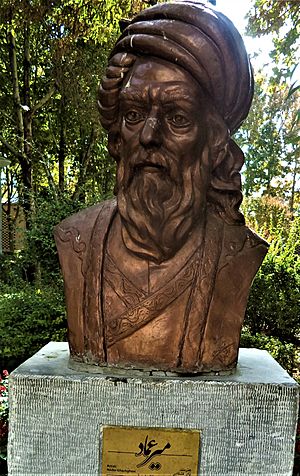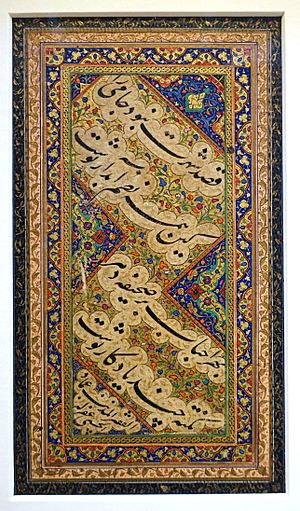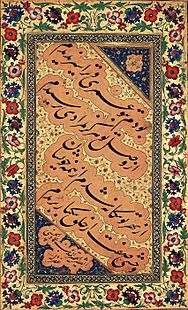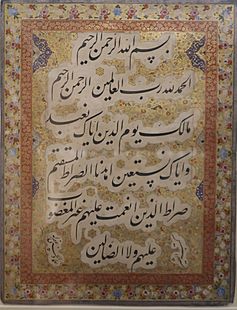Mir Emad Hassani facts for kids
Quick facts for kids
Mir Emad Hassani
میرعماد حسنی قزوینی |
|
|---|---|

Bust of Mir Emad Hassani
|
|
| Born | 1554 CE Qazvin, Iran |
| Died | 1615 (aged 60–61) Isfahan, Iran |
| Occupation | Calligraphy |
| Period | Safavids |
| Genre | Persian Calligraphy |

Mir Emad (born Emad al-Molk Qazvini Hasani, Persian: میرعماد حسنی قزوینی, 1554 – August 15, 1615) was a very famous Persian calligrapher. He was born in Qazvin, Iran. Many people believe that the Nastaʿlīq style of writing became its most beautiful and elegant through Mir Emad's amazing artworks. His calligraphies are considered some of the best examples of Nastaʿlīq writing and can be found in museums all over the world.
Contents
Early Life and Education
Mir Emad grew up in Qazvin, where he first went to school. His family members often worked as librarians and accountants for the Safavid royal court. Mir Emad began learning calligraphy from Isa Rangkar, and then from Malek Deylami.
Later, Mir Emad moved to Tabriz to continue his studies with Mohammad Hossein Tabrizi. After that, he traveled to different places like the Ottoman Empire, Baghdad, Halab, and Hijaz. He eventually returned to Semnan. He worked as a scribe, which means someone who copies documents, in Shah Abbas's library. Later, he worked in the Shah's court in the capital city of Isfahan.
Rivalry with Ali Reza Abbasi
Mir Emad was not the only talented calligrapher working for Shah Abbas. Another famous calligrapher named Ali Reza Abbasi Tabrizi also worked for the Shah. Interestingly, Ali Reza Abbasi had also been a student of Mohammad Hossein Tabrizi, who was Mir Emad's teacher. Over time, Ali Reza Abbasi became a rival to Mir Emad.
The End of His Life
Sadly, Mir Emad was later accused of being a Sunni Muslim. During the Safavid rule, this was not allowed. Because of this accusation, Shah Abbas indirectly ordered his death. One night, while on his way to a public bath, Mir Emad was killed by Masud Beik Mesgar Qazvini. For several days, no one dared to bury his body. Finally, his student, Abu Torab Khattat Esfahani, buried him in the Maghsoudbeyk mosque. However, Abu Torab was not allowed to build a special tomb for Mir Emad.
His Works and Family Legacy
Mir Emad is believed to have written a book called "Adab al-Masq," which is about how to write beautifully. His daughter, Goharshad, was also a very skilled calligrapher. Her husband, Mir Mohammad Ali, and their sons Mir Rashid, Mir Abd al-Razzaq, and Mir Yahya, were also calligraphers. Mir Emad's son, Mirza Ebrahim, was also known for his calligraphy, as was Mohammad Amin, Mirza Ebrahim's son. This shows how the art of calligraphy was passed down through Mir Emad's family.
See also
- Persian calligraphy



